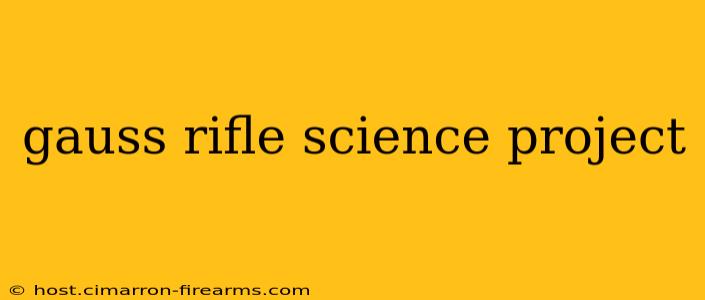The Gauss rifle, a fascinating application of electromagnetism, offers a captivating science project that delves into physics principles and engineering challenges. This guide provides a comprehensive overview, from understanding the underlying science to building your own Gauss rifle, ensuring a rewarding and educational experience.
Understanding the Science Behind the Gauss Rifle
A Gauss rifle, also known as a Gauss cannon, is a type of electromagnetic coilgun that uses magnetic fields to propel ferromagnetic projectiles. Unlike traditional firearms that rely on chemical energy (gunpowder), the Gauss rifle leverages the principles of electromagnetism for acceleration. The key concept lies in magnetic induction and the force exerted on a moving charge in a magnetic field.
Here's a breakdown of the core physics:
- Electromagnetism: Passing an electric current through a coil of wire generates a magnetic field. The strength of this field is directly proportional to the current and the number of turns in the coil.
- Magnetic Force: When a ferromagnetic projectile (typically a steel ball bearing) enters this magnetic field, it experiences a force that propels it forward. The stronger the magnetic field, the greater the force.
- Staging: Effective Gauss rifles utilize multiple stages. Each stage consists of a coil that energizes sequentially, accelerating the projectile further with each stage. This staged approach is crucial for achieving significant velocity.
- Energy Transfer: The energy for propulsion comes from the electric current supplied to the coils. Efficient energy transfer is key to maximizing the projectile's velocity.
Key Components of a Gauss Rifle:
- Electromagnets: These are the heart of the system, generating the magnetic fields that propel the projectile. Typically, they consist of coils of wire wound around a core.
- Capacitors: These store the electrical energy that's discharged to power the electromagnets. Larger capacitors can store more energy, leading to higher projectile velocities.
- Switching Circuitry: This controls the timing and sequence of energizing each electromagnet. Proper synchronization is crucial for efficient acceleration.
- Projectile: Usually a small steel ball bearing, chosen for its ferromagnetic properties and ease of handling.
- Barrel: A guide for the projectile, ensuring it stays aligned with the electromagnets. The barrel's material should minimize friction.
Building Your Gauss Rifle: A Step-by-Step Guide
While building a Gauss rifle can be challenging, it's a rewarding project that teaches valuable skills in electronics, mechanics, and physics. This is a simplified approach suitable for a science project; more advanced designs exist.
Note: Always prioritize safety. Work with adult supervision and handle high voltages with extreme caution.
Materials:
- PVC pipe (for the barrel)
- Copper wire (for the coils)
- Steel ball bearings (for projectiles)
- Capacitors (high voltage, appropriate capacitance)
- Transistors (for switching)
- Power supply (capable of providing sufficient current)
- Resistors
- Electronic components (breadboard, wires, etc.)
Steps (Simplified):
- Coil Construction: Wind multiple coils of copper wire around PVC pipe sections. The number of coils and their spacing determine the staging of the rifle.
- Capacitor Selection: Choose capacitors with sufficient voltage and capacitance to provide enough energy to the coils. The correct capacitance is crucial for optimal performance. Consult online resources for guidance on capacitor selection based on desired performance.
- Circuit Design: Design a switching circuit using transistors to control the firing sequence of each coil. This circuit requires careful planning and understanding of electronics. Consult online tutorials and diagrams for suitable circuit designs.
- Assembly: Mount the coils along the barrel, ensuring proper alignment. Connect the coils and capacitors to the switching circuit. Secure all components to prevent movement.
- Testing and Calibration: Carefully test your Gauss rifle, starting with low voltages and gradually increasing. Adjust the timing and current to optimize projectile velocity and accuracy.
Advanced Concepts and Further Exploration
This project offers a springboard for further exploration. You can investigate:
- Different coil designs: Experiment with different coil geometries and winding techniques to optimize magnetic field strength.
- Improved switching circuitry: Explore more sophisticated switching methods to enhance precision and efficiency.
- Projectile optimization: Experiment with different projectile materials and sizes to determine their effect on velocity and range.
- Computational modeling: Use simulation software to model the electromagnetic fields and predict projectile motion.
Conclusion
Building a Gauss rifle is a challenging yet rewarding science project that allows you to explore the fascinating world of electromagnetism. By carefully following the guidelines and understanding the underlying principles, you can create a functional Gauss rifle and gain valuable insights into physics and engineering. Remember safety first and always seek adult supervision when working with electricity. This project offers a fantastic opportunity for hands-on learning and scientific investigation.

